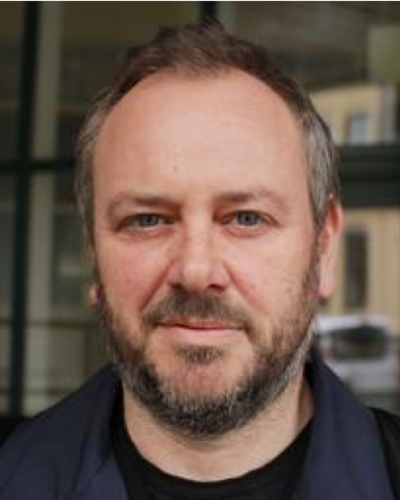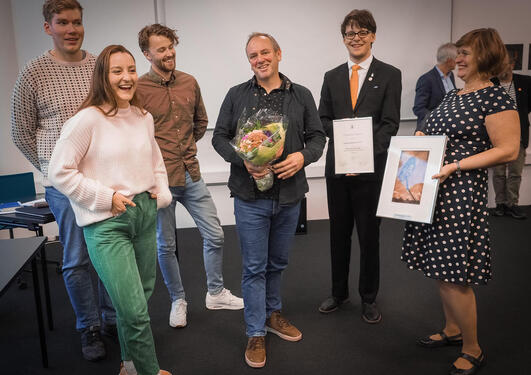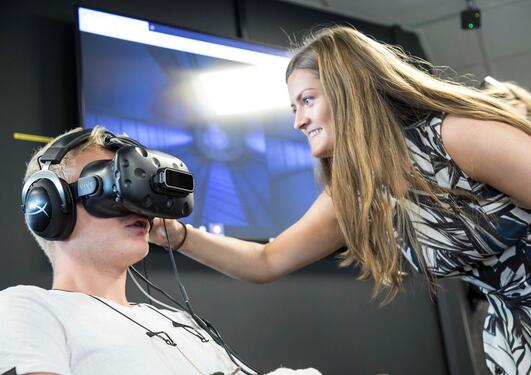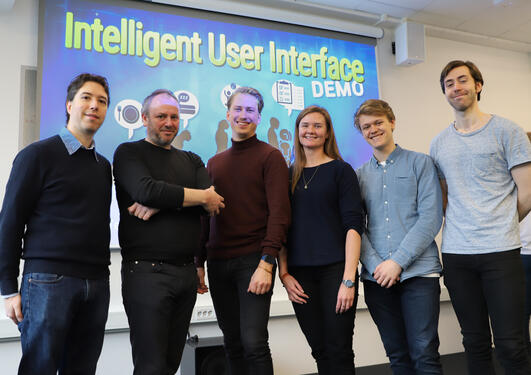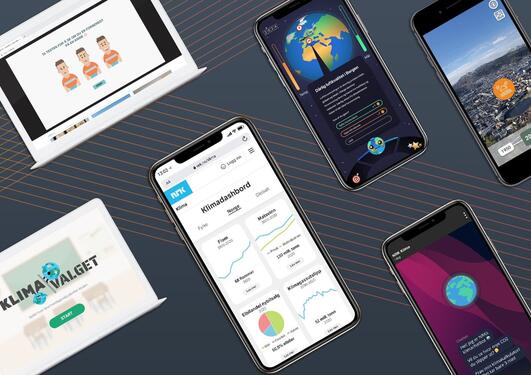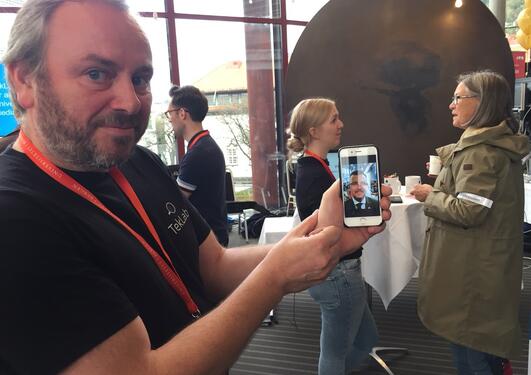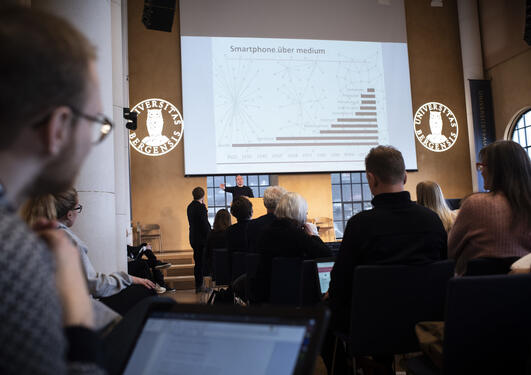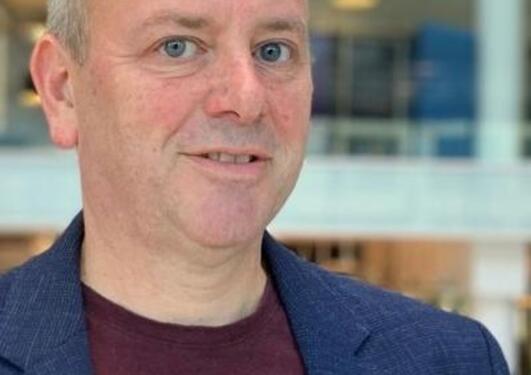Lars Nyre
- E-maillars.nyre@uib.no
- Phone+47 55 58 91 33
- Visitor AddressFosswinckels gate 6Lauritz Meltzers hus5007 BergenRoom641
- Postal AddressPostboks 78025020 Bergen
In the Norwegian system an academic has four main obligations: research, communication, teaching, and innovation. The menus presenting my academic career are organized according to these four categories. You can read about each by clicking on the menus above.
This section introduces my general approach to the four obligations and presents an overview of my career.
Researcher autonomy
Academia allows me to disregard short-term expectations of profit and use-value. As a professor at the University of Bergen in the democratic state of Norway I have the privilege of deciding the content of my research and innovation according to my own values, and also to explore and formulate those values over a long period of time with the methods and theories I see fit. I use this privilege for maximum effect in my exploration of new media technologies.
My research is not value free at all; it is guided by the norms of local democracy, the ideal of good communication, and technological sustainability. My main objective is to stimulate excellence in the development of local and regional media technologies in Norway. More specifically, three technology complexes have been at the center of my attention for a number of years: support tools for journalism, immersive media and climate change communication.
Collaboration with colleagues and students are the most valuable resources by which I can explore long term scenarios and radical solutions.
Biography
Lars Nyre (born 1969) comes from the farm Nyre in the town of Voss in Hordaland. He lives in the Bergen suburb Minde with his partner Barbara and has three grown-up children. Lars has studied and/or worked at the Infomedia Department at the University of Bergen since 1990. He became an associate professor in 2008 and a full professor in 2012.
From 2019 to 2024 Lars is also a professor II at the Department of Media and Social Studies at the University of Stavanger. He was a professor II at Volda University College from 2008 to 2010, and also conducted his PhD work at Volda from 1997 - 2003.
Lars Nyre enjoys music under the pseudonym DJ Syrenyre.
Employment and education
This is a reverse chronological list of my employment history.
- 2012 - present: Professor at the Department of Information Science and Media Studies (UiB).
- 2019 - 2024: Professor II at the Department of Media and Social Studies, University of Stavanger.
- 2023 -: Head of the program committee for media and interaction design and human computer interaction (MIX/HCI) at Infomedia, UiB.
- 2021 - 2023: Member of the program committee for media and interaction design and human computer interaction (MIX/HCI) at Infomedia, UiB.
- 2018 - 2019. Researcher (10 %) in the research project NewsAngler funded by the Norwegian Research Council.
- 2018: Interim chair of the program committee for media and interaction design (MIX) at Infomedia.
- 2016 - 2020. Researcher (20 %) in the research project Vismedia funded by the Norwegian Research Council..
- 2016 - 2018: Researcher (10 %) in the EU Innovation Action INJECT.
- 2013: Six-month research stay at City University London and London School of Economics, July to December 2013.
- 2009 - 2013: Editor of the Norwegian Journal of Media Studies.
- 2008 – 2012: Associate professor at the Department of Information Science and Media Studies (UiB).
- 2008 – 2010: 20 % research position at the School of Journalism at Volda University College, in collaboration with the NFR project “Journalistikk i endring” (JOSAM).
- 2007 – 2008: Part-time teacher and researcher at Department of Information Science and Media Studies, University of Bergen.
- 2005-2008: Web Editor and responsible for website design and database development for the ECREA website.
- 2003 – 2006: Post doctor in media studies, Department of Information Science and Media Studies, University of Bergen. Funded by the Norwegian Research Council, under the Culture, ICT and Media programme (KIM).
- 2004: Six-month research stay at Royal Holloway University, London, UK, January to June 2004.
- 1998 – 2003: Ph.D. candidate at the Department of Media Studies at the University of Bergen and the School of Journalism at Volda University College. Doctoral dissertation was defended in May 2003.
- 2000: Six-month stay at Stony Brook University, New York, USA, January to June 2000.
- 1997: Completion of licentiate thesis (hovudfag) in media studies, Department of Information Science and Media Studies, University of Bergen.
- 1995 – 1996: Full-time position as cultural editor of the student newspaper Studvest, Bergen.
- 1993: «Mellomfag» in media studies, University of Bergen.
- 1992: «Mellomfag» in literary studies, University of Bergen.
- 1991: «Grunnfag» in media studies, University of Bergen.
- 1989: «Grunnfag» in English, University of Bergen.
- 1989 – 1990: Full-time position as news journalist in the local paper Vaksdal Posten, Vaksdal.
- 1987 – 1988: Part-time position as news journalist in the local paper Horda Tidend, Voss.
Responsibilities
This is a list of important responsibilities that my position has allowed me to have.
- 2022 - 2024: Director of a 5.000.000 NOK pedagogical project called "TekLab Enterprise". Funded by HK-dir.
- 2021 - 2023: Director of a 5.000.000 NOK pedagogical project called "Innovation Pedagogy for Media Education". Funded by HK-dir.
- 2020 - 2022: Member of the NORDFORSK research network "Augmented Journalism".
- 2012 - present: Director of the academic network variously called tvertek, J-lab and TekLab.
- 2015 - 2016: Jury member of Fritt Ords youth prize for Freedom of Speech.
- 2010 to 2015: Chair of the research network “ICT and Media” under the umbrella of UH-nett Vest.
- 2010 to 2011: Member of “Resource group for media”, in Bergen Chamber of Commerce and Industry.
- 2010 to 2013: External censor for Institutt for medier og kommunikasjon, UiO.
- 2010 to 2014: Member of the Management Committee for Norway of COST Action “Transforming Audiences, Transforming Society”.
- 2009 to 2011: Member of the NORDFORSK research network "The Culture of Ubiquitous Information".
- 2010 to 2018: Member of the research group Digital Radio Cultures in Europe.
- 2009 to 2012: Chair of the research group TVERTEK which also ran T-lab, a modest research laboratory located at UiB.
- 2009 – 2010: Member of the program committee for the journalism bachelor’s degree at Infomedia, UiB.
- 2008 to present: Member of the international board of the Journal of Radio and Audio Media.
- 2008 – 2010: Member of the program committee for the conference Nordic Media Festival, which attracts over a thousand journalists and TV-producers to Bergen in May every year.
- 2004 – 2009: Chair of the research group Digital Radio Cultures in Europe, originally established as part of the EU-funded COST A20 network “The Impact of the Internet on the mass media in Europe”.
- 2003 - 2008: Executive board member of ECREA. From 2003-2005 I was board member of European Communication Association (ECA) which merged with the European Consortium of Communication Research (ECCR) to form ECREA in 2005.
- 2006: PhD course. Nyre was responsible for the international doctoral course “Technology and the Public Sphere” 14-17 November 2006. Twenty doctoral students from across Europe and keynote speakers Andrew Feenberg, Brian Winston and Peter Dahlgren attended. Funded by the University of Bergen and the Norwegian Council of Research and organized as part of the European Communication Research and Education Association (ECREA).
- 2004: Member of the organization committee for the conference ECA Istanbul Conference 2004, in Istanbul, Turkey, April 2004.
- 2003-2005: Chair of the “Radio and Sound Media Group” in the Nordic Media Researcher Association.
- 2001-2006: Norwegian delegate for radio and music to the EU-funded network COST A20, called “The Impact of the Internet on the mass media in Europe”. Management committee member representing Norway from 2004-2006.
In the Norwegian system an academic has four main obligations: research, teaching, communication, and innovation. This section presents my communication activities. You will find a more comprehensive presentation in the Norwegian section.
Ambivalence towards artificial intelligence
I am responsible for a major communication initiative at the University Museum at UiB from June to December 2024. The TekLab project, which I am the director of, organizes a collaboration between students in Media City Bergen and the curators at the University Museum. The students are creating an exhibition about "ambivalence towards artificial intelligence" which will be on display for six months and may attract up to 40,000 visitors.
Future Fest
I was responsible for a large communication initiative in Media City Bergen on 17 August 2023. The project TekLab, which I am the director of, invited the 450 participants at the Nordmedia conference to what we called Future Fest. Here we presented a total of 13 prototypes of new media designs that aim to counteract the future shock Norwegian academia seems to suffer from. The event was organized by the student staff at TekLab in collaboration with Media Futures and Media City Bergen.
Communication autonomy
As a professor at the University of Bergen I am expected to communicate research results and academic insights to the general public. This is a central part of the job, but it is very difficult to balance against academic autonomy. It is important not become an "expert" on everything and nothing, and to avoid becoming a voice for the needs of journalists and communicators instead of the needs of the university and my own research.
My autonomous approach was formulated in an essay in 2012. I had become increasingly frustrated with the subordinate role that researchers enter into as interview objects for the national and regional press. I wrote a critical essay where I explained the problem and announced that I would withdraw from the role of an interview object and pursue other avenues of communication. You can read the Norwegian language essay here: Journalistikken koloniserer universitetet.
I mainly communicate my research on independent media platforms outside the mainstream press circuit. Furthermore, I never accept fees or salaries for speeches or lectures, and almost never speeches in the private sector. My communication activities take place within the framework of position as a professor in Bergen and Stavanger. My public reach is therefore limited, but at least highly controlled. My public communication is coherent, consistent and cumulative, but it is not spread as widely in the Norwegian public as it could have been if I gave up these principles.
Please consult the Norwegian language section on “Formidling” to read more about my activities in this field.
In the Norwegian system an academic has four main obligations: research, teaching, communication, and innovation. This section presents my teaching activities.
Teaching autonomy
My teaching is solution oriented. I am more concerned with the future than with the past, and I try to teach my students how to construct valuable media solutions for the future. Three technology complexes are at the center of my attention as a teacher as well as a researcher: support tools for journalism, immersive media, and climate change communication.
The constructive, solution-oriented approach creates a certain tension with the normal way of doing things. While it is very important with analytical approaches to historical and ongoing social developments, it is also important to work with design, innovation, and entrepreneurship. A serious reorientation is needed to make media departments at universities better able to teach these skills.
I am among the relatively few academics who get their fingers dirty with innovation and entrepreneurship. You have to be a diplomat, a salesman and a zealot, and you have to write a million emails. Many chose academia to avoid just such work.
However, it is just as intellectually demanding for students to design new solutions for media businesses as it is to read Pierre Bourdieu and apply his theories on social relations. The possibilities for dialogue, criticisms and conflict are just as vital too.
Innovation pedagogy
I have taught media studies and media design since 2008 when I was employed as an associate professor at the University of Bergen. My teaching has been increasingly characterized by an effort to explore technological innovation along with students. The approach is called innovation pedagogy. Please read this short article about innovation pedagogy at the UiB Website.
This approach presumes that students have to tackle the permanent disruption going on in the media industry in order to get relevant jobs and contribute to society. Our proposition is that the best way to prepare, is by evaluating and making prototypes of new and emerging media solutions in collaboration with local and regional media companies.
Please consult the Norwegian language section on “Undervisning” to read more about my activities in this field.
In the Norwegian system an academic has four main obligations: research, teaching, communication and innovation. All of these activities are supposed to lead to publication, and here I present an overview of my publication history.
Publication autonomy
My research, teaching and innovation is based on media studies, but has the interdisciplinary goal of building a bridge between theoretical and practical activities. I collaborate with both theoretically oriented researchers and teachers in practical areas within journalism, TV production and other media forms. It is also a goal to build a bridge between thematic areas such as philosophy and media studies, business development and media studies and climate research and media studies.
Media design: synthetic media studies
Karl Marx said that the scientist cannot just interpret the world; he must change the world directly. Media researchers cannot just analyze the media, we must create new media. I want to know as much as possible about the connection between media technology, content production and human experience. Every prototype we make tell us a lot about what did not work, and a little bit about what's worth investing in.
I want to facilitate the exploration of responsible design and innovation projects related to new media technology, and I consider that I’m conducting a special type of media studies called synthetic.
Most media studies are based on approaches from the humanities and social sciences and are fundamentally analytic. Analysis is critical. It assesses weaknesses, contradictions, and bad effects on people’s lives. Analysis consists of taking apart what has already been put together to look critically at its components. It is a past-oriented research practice, where the researcher uses methods that can help gather information about cultural and social practices to analyze their qualities. This makes the humanities and social sciences bad at orienting to the future.
My claim has long been that analysis is not enough! There must be synthetic media studies. Synthesis consists of putting together components into a new whole that is greater than the sum of its parts. Synthesis is constructive by trying to solve the problems that are currently being pointed out by analysts.
There must be well-informed studies that lead to proposals for new solutions to solve the problems pointed out. Media scholars are typically not willing to go down this road.
Research publications in media design
- Maiden, Neil, Konstantinos Zachos, Suzanne Franks, Lars Nyre & Carl-Gustav Linden (2023) Automating Science Journalism Tasks: Emerging Opportunities. In Journalism Practice. DOI: https://doi.org/10.1080/17512786.2023.2226116 (open access).
- Nyre, Lars och Fredrik Håland Jensen (2023, under publisering) Mediedesign: en postnormal undersökning av framtidens tekniska medielösningar. I Martin Berg, Maria Engberg & Sara Leckner (red.). Tekniska mediestudier. En introduktion till metoder och teknologier. Stockholm: Studentlitteratur.
- Vindenes, Joakim and Lars Nyre (2023, forthcoming) Prototyping first-person viewer positions for VR narratives with storyboards and pilot productions. Special Issue of the Journal of Screenwriting.
- Nyre, Lars and Neil Maiden (2022) Can action research improve local journalism? In Nordicom Review 43 (2): 171 - 189. DOI: https://doi.org/10.2478/nor-2022-0011.
- Nyre, Lars (2021) Designing collective intelligence to improve the democratic public. A dialogue between Anna De Liddo and Lars Nyre. In Norsk medietidsskrift 28(2). Side 1–8. DOI: https://doi.org/10.18261/ISSN.0805-9535-2021-02-06
- Nyre, Lars and Joakim Vindenes (2020) Immersive journalism as witnessing. In Uskali, Turo & Astrid Gynnild (eds) Immersive Journalism as Storytelling: Ethics, Production and Design. London: Routledge (Media and Journalism Studies).
- Nyre, Lars (2020) Tre spørsmål om metodeutvikling i medievitskapen. Norsk medietidsskrift 27(1). Side 1–5. https://doi.org/10.18261/ISSN.0805-9535-2020-01-08.
- Maiden, Neil, Lars Nyre et.al. (2018) Making the News: Digital Creativity Support for Journalists. CHI '18: Proceedings of the 2018 CHI Conference on Human Factors in Computing Systems. Paper No.: 475. Pages 1–11. DOI: https://doi.org/10.1145/3173574.3174049
- Hoem, Jon og Lars Nyre (2018) Tilhører. En prototype på fremtidens omsluttende radio. Norsk medietidsskrift 25(1): 1–19. DOI: https://doi.org/10.18261/issn.0805-9535-2018-01-04
- Guribye, Frode, Lars Nyre & Astrid Gynnild (2018) Kameradroner som journalistisk verktøy - et designeksperiment i høyere utdanning. I Astrid Gynnild (Red.) Droner i sivilsamfunnet. Oslo: Cappelen Damm Akademisk, p. 101-120.
- Nyre, Lars, Frode Guribye & Astrid Gynnild (2018) «Taking risks with drones. Responsible innovation pedagogy for media education". In Gynnild & Uskali (eds.) Responsible Drone Journalism. Abingdon: Routledge Focus, p. 71-85.
- Nyre, Lars, Joao Ribeiro and Bjørnar Tessem (2018) «Business models for academic prototypes. A new approach to media innovation». Journal of Media Innovation 4(2).
- Midtun, Joar, Bjørnar Tessem, Simen Karlsen & Lars Nyre (2017) "Realistic face manipulation by morphing with average faces". Norsk Informatikkonferanse 2017. Henta frå https://ojs.bibsys.no/index.php/NIK/article/view/426.
- Nyre, Lars, Jon Hoem, Bjørnar Tessem & Johannes Ringheim (2017) Designing the Auditor: A Prototype of Locative Radio with Original Sound Content. Journal of Radio & Audio Media 24(1): 90-110.
- Tessem, Bjørnar, Simen Skaret Karlsen og Lars Nyre (2016) "Mobilen som distribusjonskanal for hyperlokale nyheiter". NOKOBIT.
- Bjørnar Tessem, Solveig Bjørnestad, Weiqin Chen, Lars Nyre (2015) «Word Cloud Visualisation of Locative Information», Journal of Location-based Services. 9(4): 254-272.
- Nyre, Lars (2015) Akademiske prototypar. Ei retning for medieutviklinga på Vestlandet i Bjerke, Paul, Lewe, Thomas, Sivertsen, Erling, Strøm, Gunnar og Werenskjold, Rolf (red) (2015) Festskrift for Sverre Liestøl. Oslo: Forlag 1, s. 165-181.
- Nyre, Lars (2015) "Designing the Amplifon. A locative sound medium to supplement DAB radio". Journal of Media Innovations, vol 2(2): 58-73).
- Nyre, Lars (2014) ”Amplifon. På sporet av et mer intelligent radiomedium”. Nordicom-Information 36(4): 92-96.
- Nyre, Lars (2014) ”God lokaljournalistikk berre på nett: Hypotetisk redesign av avisa Hordaland på Voss”, in Krumsvik and Morlandstø (eds) Innovasjon og verdiskaping i lokale medier, Cappelen Damm Høyskoleforlaget 2014.
- Nyre, Lars (2014) “Media design method. Combining media studies with design science to make new media”. Inaugural issue of Journal of Media Innovations. Vol 1(1).
- Nyre, Lars, Solveig Bjørnestad, Bjørnar Tessem and Kjetil Vaage Øie (2012) Locative journalism: Designing a location-dependent news medium for smartphones. Convergence18(3): 297–314. DOI: DOI: https://doi.org/10.1177/1354856512441151
- Nyre, Lars (2010) ”Experimenting with new media for journalism”, in Nordicom Information 32(2-3): pp. 83-93.
- Nyre, Lars (2007) Minimum journalism. Experimental procedures for democratic participation in sound media. Journalism Studies 8(3): 397-413. DOI: https://doi.org/10.1080/14616700701276158
Cristin
Below you will find a list of all my registered publications in the official Norwegian database of research publications «Cristin».
- (2023). “Den førerløse samfunnsmaskinen”. En samtale mellom Lars Nyre og Lena Lindgren om teknologi og determinisme.
- (2023). Prototyping first-person viewer positions for VR narratives with storyboards and pilot productions. Journal of Screenwriting. 251-269.
- (2023). Mediedesign: en postnormal undersökning av framtidens tekniska medielösningar. . In:
- (2023). Tekniska mediestudier. En introduktion till metoder och teknologier. Studentlitteratur AB.
- (2023). Korleis fungerer eigentleg ChatGPT? Dag og Tid.
- (2023). Kor mange maskiner har elsparkesykkelen? Dag og Tid.
- (2023). Den mest avanserte teknologien. Dag og Tid.
- (2023). Automating Science Journalism Tasks: Emerging Opportunities. Journalism Practice.
- (2022). Varmeteknologi. Dag og Tid.
- (2022). Teknisk ekspertise. Dag og Tid.
- (2022). Synkronisert klokketid. Dag og Tid.
- (2022). Sjakkprogrammet Stockfish. Dag og Tid.
- (2022). Signal. Dag og Tid.
- (2022). Samtale med datamaskiner. Dag og Tid.
- (2022). Programmeringsspråk. Dag og Tid.
- (2022). Nøkkelkort. Dag og Tid.
- (2022). NOKUT-PODDEN. Gjestar i NOKUT sin eigen podkast. Snakka om innovasjonspedagogikk. .
- (2022). Modellvisingskontroll. Dag og Tid.
- (2022). Metaverset. Dag og Tid.
- (2022). LED-pærer. Dag og Tid.
- (2022). Klokka. Dag og Tid.
- (2022). Innovasjonspedagogikk for medieutdannningar.
- (2022). Informasjonskapslar. Dag og Tid.
- (2022). Framveksande teknologiar. Dag og Tid.
- (2022). Enkle maskiner. Dag og Tid.
- (2022). Elektronisk papir. Dag og Tid.
- (2022). Eksplosjonsteknologi. Dag og Tid.
- (2022). E-post. Dag og Tid.
- (2022). Den enklaste teknologien. Dag og Tid.
- (2022). Deep Learning to Encourage Citizen Involvement in Local Journalism.
- (2022). Darwin blant maskinene. Hvordan evolusjonsteorien forklarer at noen oppfinnelser lykkes, og andre mislykkes . REPLIKK – Tidsskrift for samfunnsvitskap og humaniora.
- (2022). Can action research improve local journalism? Nordicom Review. 171-189.
- (2022). Blinklys. Dag og Tid.
- (2022). Betalingsterminalar. Dag og Tid.
- (2022). Antibiotika. Dag og Tid.
- (2021). Veivakselen. Dag og Tid.
- (2021). Universalmaskina. Dag og Tid.
- (2021). Trykkskjermar. Dag og Tid.
- (2021). Ting i internettet. Dag og Tid.
- (2021). Søppelpost-filter. Dag og Tid.
- (2021). Systemutvikling. Dag og Tid.
- (2021). Støydempande høyretelefonar. Dag og Tid.
- (2021). Sosiale robotar. Dag og Tid.
- (2021). Sjølvkøyrande bilar. Dag og Tid.
- (2021). Protokollar. Dag og Tid.
- (2021). Prateprogramvare. Dag og Tid.
- (2021). Posisjoneringssystem. Dag og Tid.
- (2021). Navigasjonssystem. Dag og Tid.
- (2021). Kvifor Google-briller vart ein fiasko. Dag og Tid.
- (2021). Kva datamaskiner kan gjere. Dag og Tid.
- (2021). Krypterte handtrykk. Dag og Tid.
- (2021). Innovation Pedagogy for Experimental Journalism.
- (2021). Immersive Journalism as Witnessing 1.
- (2021). Hofteproteser. Dag og Tid.
- (2021). Fritidsdronar. Dag og Tid.
- (2021). Databasar. Dag og Tid.
- (2021). Bærplukkarrobotar. Dag og Tid.
- (2021). Blikksporing. Dag og Tid.
- (2021). Automatiske nyhende. Dag og Tid.
- (2021). Auka røynd (AR). Dag og Tid.
- (2021). Algoritmar. Dag og Tid.
- (2020). «The climate choice – A game where your everyday choices affect the globe» for the Natural history Museum UiB, by Susanne S. Clausen, Simon R. Iden, Hector I. A. Pena, Martine L. Rafteseth & Emma D. E. Risan.
- (2020). Vi testet innovasjonspedagogikk og er fornøyd med resultatet. Bedre Skole.
- (2020). Tre spørsmål om metodeutvikling i medievitskapen. Norsk Medietidsskrift. 1-5.
- (2020). Test our Prototypes for Climate Communication. ViSmedia.
- (2020). Teknologi tek over. Bergens Tidende.
- (2020). Tech Giants, Artificial Intelligence, and the Future of Journalism, Jason Paul Whittaker . European Journal of Communication. 315-316.
- (2020). Swift Media - bringer dine lokalnyheter raskt ut i sosiale medier av av Justine Fonn Sætre, Peder Holtermann Solland, Simen Nykås, Johannes Langelo, Margrethe Meling. .
- (2020). Students Take Charge of Climate Communication. ViSmedia.
- (2020). Studenter lager medieløsninger for unge brukere. TekLab.
- (2020). Sandnesposten Instatips - vær med å bestemme innholdet i avisa, av Alesja Varemjova, Henrik Gulsrud, Atle Bertelsen Leerstang, Erlend Stærk Farbu og Hilde Kåstad.
- (2020). Read our Critical Evaluations of Climate Communication. ViSmedia.
- (2020). NRK din radio - en radiosending skapt for deg, av Louise Galapati Larsen, Bror Vebjørn Remen, Jarl Anders Ruset Hjelle, Simen Sørensen Westgaard og Karolina Perzynska.
- (2020). Mediestudenter med et reelt innblikk i gründer-livet.
- (2020). Les studentenes planer for redaksjonell nyvinning i Stavangermediene. TekLab.
- (2020). Innovasjonspedagogikk i Media City Bergen.
- (2020). Innovasjonspedagogikk for medieutdanninger. TekLab.
- (2020). Essayføljetong 4:9 — Teknologiane vert sterkare av seg sjølv. Vox publica.
- (2020). Essayføljetong 3:9 — Tradisjonell etikk har gått ut på dato. Vox publica.
- (2020). Essayføljetong 2:9 Framtida er viktigare enn notida. Vox publica.
- (2020). Essayføljetong 1: 9 Hans Jonas og problemet med moderne teknologi. Vox publica.
- (2020). Emergency preparedness calculator for NRK, by Angeltveit, Andrea, Bråthen, Anniken Kjos, Flatebø, Hanna Haug, Undal, Lene Ji Huang, Øijorden, Emilie Rødseth .
- (2020). Digital Creativity Support for Original Journalism. Communications of the ACM. 46-53.
- (2020). Difor vert du sliten av videomøte.
- (2020). Derfor blir du sliten av videomøter. Bergens Tidende.
- (2020). Climategotchi. Your virtual globe for Natural History Museum UiB, by Eide, Joachim Woll, Holmsen, Maj-Inga, Kojelyte, Kornelija, Larsen, Anette Kallevåg, Lyssand, Marianne .
- (2020). Climatecalculator V.2 for NRK, by Aarvik, Bjørne Ellefsen, Ingebrigtsen, Victoria Westin, Præsttun, Helene, Torheim, Silje Marie, Westli, Willem Percyval .
- (2020). CLIMATE DASHBOARD. A user-friendly platform for reliable climate information for NRK, by Eivind Gisholt, Paula J. Ullaland, Ida Ødegård, Emilie Munthe-Kaas & lngfrid D. Næss.
- (2020). Bergen Climate Travel for Fløybanen AS, by Kristin Eidsheim, Camilla E. B. Hermansen, Tommy Kojen, Marie Presthus, Live Aadneram Enevoldsen .
- (2020). Automatisering av nyheitsarbeid i lokalaviser. TekLab.
- (2020). Aftenbladet GjenVinn - handling over ord, vi må redde moder jord! av Morten Stareng Gundersen, Jo Fridstrøm, Kjellaug Lund, Hanna Hiim Sindre og Victoria Løvold Larssen.
- (2020). Aftenbladet Det skjer - kun de arrangementene du er interessert i, av Mali Marie Ytterli Øvrebø, Erlend Borren Kristoffersen, Arber Maliqi, Kylo Salvesen og Marius Døskeland Hope.
- (2019). Vitnemaskina - ei vidareføring av AI Narrator.
- (2019). Vi lagar teknologi. Innovasjonspedagogikk i Media City Bergen.
- (2019). Vi lagar ny teknologi. Innovasjonspedagogikk i Media City Bergen.
- (2019). Tør du ta på deg VR-drakta? Forskning.no.
- (2019). Towards a Big Data Platform for News Angles. CEUR Workshop Proceedings. 17-29.
- (2019). Students at the Vanguard of Innovation. ViSmedia.
- (2019). Studenten som deltakar i staden for tilskodar. På Høyden ( UiBs nettavis).
- (2019). Resistance to interdisciplinary research.
- (2019). Nyheter, til deg, der du er: Utvikling av lokativ journalistikk for mobile enheter – et pragmatisk perspektiv. 2019/234.
- (2019). Kor kan vi lande? Bokessay om Bruno Latours "Down to Earth" (2018). Klassekampen.
- (2019). Innovasjonspedagogikk i Media City Bergen .
- (2019). Innovasjonspedagogikk i Media City Bergen .
- (2019). Innovasjonspedagogikk i Media City Bergen.
- (2019). Innovasjonspedagogikk i Media City Bergen.
- (2019). Innovasjonspedagogikk.
- (2019). IF … THEN: Algorithmic power and politics (book review). New Media & Society. 1877-1879.
- (2019). Exploring News Reading With Eye-Tracking and Stress Measurements. ViSmedia.
- (2019). Ekko: Automatiske nyheter ved hjelp av kunstig intelligens. TekLab.
- (2019). Det er svært vanskeleg å få publisert tverrfaglege artiklar. Forskerforum.
- (2019). Automatisert produksjon og publisering av journalistikk - hva skjer med redaktørrollen og etikken?
- (2018). Transgressiv mediedesign – forskning på farleg teknologiar . Vox publica.
- (2018). Towards a Big Data Platform for News Angles.
- (2018). Tilhører – En prototype på fremtidens omsluttende radio. Norsk Medietidsskrift. 1-19.
- (2018). Teknologien tek over.
- (2018). Taking risks with drones: responsible innovation pedagogy for media education. 14 pages.
- (2018). Principles for an AI Narrator.
- (2018). Making the news: digital creativity support for journalists . ACM CHI on human factors in computing systems conference proceeding.
- (2018). Making business models for academic prototypes. A new approach to media innovation. The Journal of Media Innovations. 4-19.
- (2018). Kameradroner som journalistisk verktøy - et designeksperiment i høyere utdanning. 16 pages.
- (2018). Journalistikk i laboratoriet. Nye teknologier og gamle uttrykksformer .
- (2018). Innovation pedagogy in Media City Bergen.
- (2018). Innovation Pedagogy for VR Journalism.
- (2018). Innovasjonspedagogikk i Media City Bergen .
- (2018). Innovasjonspedagogikk i Media City Bergen.
- (2018). Innovasjonspedagogikk i Media City Bergen.
- (2018). Innovasjonspedagogikk i Media City Bergen.
- (2018). Innovasjonspedagogikk i Media City Bergen.
- (2018). Innovasjonspedagogikk i Media City Bergen.
- (2018). Innovasjonspedagogikk for arbeidslivet. .
- (2018). Innovasjonspedagogikk for arbeidslivet i Media City Bergen.
- (2018). Innovasjonspedagogikk for arbeidslivet .
- (2018). Hot topics – Watching in the media (paneldebatt).
- (2018). Folkeopplysning på stranda med mobilen i handa. Norsk Medietidsskrift.
- (2018). Exploring the expressive register of VR journalism with innovation of pedagogy .
- (2018). Book Review: Nick Couldry and Andreas Hepp, The Mediated Construction of Reality. New Media & Society. 3955-3958.
- (2017). The Changing Ecology of Tools for Live News Reporting. Journalism Practice. 1216-1230.
- (2017). Realistic face manipulation by morphing with average faces. NIKT: Norsk IKT-konferanse for forskning og utdanning. 12 pages.
- (2017). RPAS Operasjonsmanual for Universitetet i Bergen.
- (2017). Lydjournalistikk : innføring i radio og podkasting. Det Norske Samlaget.
- (2017). Facial recognition and manipulation of news images – an experiment.
- (2017). Designing the auditor: a prototype of locative radio with original sound content. Journal of radio & audio media. 90-110.
- (2017). Bygg kontrolltårnet nå! En kritikk av den analytiske medievitenskapen. Nordicom Information. 7-11.
- (2016). What is teletext? 16 pages.
- (2016). Smartdroner i medieutdanningen ved UiB – lessons to be learned.
- (2016). Norsk radio må reddast. Bergens Tidende.
- (2016). Micro-positioned Storytelling in Sound – Field Trial Evaluation of a Media Prototype.
- (2016). MOBILEN SOM DISTRIBUSJONSKANAL FOR HYPERLOKAL JOURNALISTIKK. NOKOBIT: Norsk konferanse for organisasjoners bruk av informasjonsteknologi. 16 pages.
- (2016). Locative Storytelling in Sound.
- (2016). Det gode ved dronen. Bergens Tidende.
- (2016). Camera drones in education. Teaching students to make responsible journalism with new technology.
- (2016). Camera Drone Education: First Nordic Experiences with Pilot Courses.
- (2015). Word cloud visualisation of locative information. Journal of Location Based Services. 254-272.
- (2015). Verdiskaping i Media City Bergen. Bergens Tidende.
- (2015). Urban Headphone Listening and the Situational Fit of Music, Radio and Podcasting. Journal of radio & audio media. 279-298.
- (2015). The usability of noise cancelling headphones while moving about in a big city .
- (2015). The acoustic bubble. A field trial of listening in noise-cancelling headphones .
- (2015). Ordsky for lokale fakta. Bergens Tidende.
- (2015). Medieforsking kan trygga mediemangfaldet. Bergens Tidende.
- (2015). Mediedesign langs Bybanen. Bergens Tidende.
- (2015). Live in the field - an ecology of tools for video journalism.
- (2015). Kritisk journalistikk på nye måtar. Bergens Tidende.
- (2015). Journalistikk for smartklokker. Bergens Tidende.
- (2015). Har radionyheitene gått ut på dato?
- (2015). Forsking i Media City Bergen. Bergens Tidende.
- (2015). Designing the Amplifon. A locative sound medium to supplement DAB radio. The Journal of Media Innovations. 58-73.
- (2015). Bringing to market an academic prototype for data-driven journalism.
- (2015). Book review: Paddy Scannell’s Television and the Meaning of Live (2014). New Media & Society. 308-310.
- (2015). Book review: Mobility and Locative Media, edited by Adriana de Souza e Sliva and Mimi Sheller. The Journal of Media Innovations. 74-76.
- (2015). Amplifon – eksperiment med lokativ lyd på mobilen.
- (2015). Akademiske prototypar. Ei retning for medieutviklinga på Vestlandet. 17 pages.
- (2015). Adoption of trust in mobile social media in a small Norwegian community.
- (2014). Media design method. Combining media studies with design science to make new media. The Journal of Media Innovations.
- (2014). God lokaljournalistikk berre på nett: Hypotetisk redesign av avisa Hordaland på Voss. 24 pages.
- (2014). Design implications for mobile journalism beyond the professional newsroom.
- (2014). Amplifon. På sporet av et mer intelligent radiomedium. Nordicom Information. 92-96.
- (2013). What does it mean to trust the media?
- (2013). Trust in the media across Europe. Communication Management Quarterly.
- (2013). The Influence of Social Media Use on Willingness to Share Location Information. Lecture Notes in Computer Science (LNCS). 161-172.
- (2013). Bruno Latour og teknologi: Moralske ikkemenneskelige aktører?
- (2012). Nico Carpentier: Media and participation: a site of ideological-democratic struggle. Intellect, Chicago IL, 2011, 360 pp ISBN: 9781841504070. New Media & Society. 1067-1069.
- (2012). Læraren veit best! UNIPED. 102-108.
- (2012). Lokaljournalistikk for mobilen. 19 pages.
- (2012). Locative journalism: Designing a location-dependent news medium for smartphones. Convergence. The International Journal of Research into New Media Technologies. 297-314.
- (2012). Journalistikken koloniserer universitetet. Nytt Norsk Tidsskrift. 329-336.
- (2012). For and against Participation: A Hermeneutical Approach to Participation in the Media. 21 pages.
- (2012). Effekten av sosiale medium-bruk på villigheit til å dele personleg informasjon på mobilen.
- (2012). BBC Broadcasts to Portugal in World War II: how radio was used as a weapon of war. Journalism Studies.
- (2011). The broadcast pulic and its problems. Javnost - The Public. 5-18.
- (2011). Experimental evaluation of tools and concepts for location-aware journalism. 8 pages.
- (2011). Design and Evaluation of a Location-based Mobile News Reader. 4 pages.
- (2010). Two-way radio : audience partipication and editorial control in the future. 20 pages.
- (2010). Sound studies is still tuning in. New Media & Society. 1388-1393.
- (2010). Review of Norwegian audience research.
- (2010). Motives for and against participating. A hermeneutical study of media participation in Norway and Ireland, 2005-2006.
- (2010). Materiality Up Front. A design approach to media research.
- (2010). Location Journalism. Experimental procedures for making location-aware news to mobile phones.
- (2010). Location Journalism. Experimental procedures for making location-aware news to mobile phones.
- (2010). Journalisten som teknologisk determinist: holdninger til søkemotorer og nettpublisering. 26 pages.
- (2010). Journalisten som teknologisk determinist.
- (2010). Experimenting with new media for journalism. Nordicom Information. 83-93.
- (2010). Digital radio in Europe : technologies, industries and cultures. Intellect Ltd..
- (2010). Designing and evaluating a mobile tool for location-based news.
- (2010). Baklengs akustisk historie.
- (2010). An experimental approach to media research.
- (2009). Normative media research moving from the ivory tower to the control tower. Nordicom Review. 3-17.
- (2009). Mikke Mus-faget slår tilbake. Norsk Medietidsskrift.
- (2008). Sound Media. From Live Journalism to Music Recording.
- (2008). Sound Media. From Live Journalism to Music Recording.
- (2007). Postphenomenology: A critical companion to ihde. International Journal of Philosophical Studies. 633-638.
- (2007). Minimumsjournalistikk : eksperimentelle prosedyrer for demokratisk deltagelse i lydmedier. 24 pages.
- (2007). An Archaeology of Sound Media from the 2000s to the 1870s.
- (2006). The Interactive Sublime: Obstacles to dialogue in digital broadcasting. 14 pages.
- (2006). Results of the COST A20 group for radio and music.
- (2006). Nye medier, gammeldags journalistikk. 17 pages.
- (2006). Gaining the Initiative. Preliminary results from a qualitative interview project.
- (2006). ECREA Online. A member database.
- (2005). Instructive media research.
- (2005). Demostation - Democratic radio on the Internet.
- (2005). Apologetic Media Research. Nordicom Review.
- (2004). Radioradio. Lyd i journalistikk. Det Norske Samlaget.
- (2004). Mediumteori. Norsk Medietidsskrift. 24-49.
- (2003). Truverde på spel. Syn og Segn. 28-35.
- (2003). Truverde på spel. Syn og Segn.
- (2003). P4-kulturen : media. Mål og makt. 10-15.
- (2003). Mediated Self-Control : Potentials of Radio and Telephone Convergence.
- (2003). Mediated Self-Control.
- (2003). Fidelity matters : sound media and realism in the 20th century : doctoral thesis.
- (2003). Bokmelding av "Se hva som skjer! : en studie av lyd som kommunikativt virkemiddel i TV" av Arnt Maasø. Norsk Medietidsskrift. 167-172.
- (2002). Mediated Self-Control.
- (2002). Format Radio Realism.
- (2001). The Vanishing Original. The Impact of Editing on Sound Fidelity.
- (2001). Sound Technology History.
- (2001). Sanselaus medievitskap. Ein kritikk av tekstteoretiske tilnærmingar til kringkasting.
- (2001). Originalen som forsvann. Om musikkinnspeling gjennom det 20. århundret.
- (2001). Omsetjing av "Ting å gjera med kjøpesenter" av Megan Morris. 26 pages.
- (2001). Omsetjing av "Reklame: det magiske systemet" av Raymond Williams. 18 pages.
- (2001). Omsetjing av "Postmoderne virtualitetar" av Mark Poster. 22 pages.
- (2001). Medier og teknologifilosofi.
- (2001). Magiske system. Klassiske tekster om medier og kultur. Spartacus.
- (2001). Magiske system. Klassiske tekster om medier og kultur. Spartacus.
- (2001). Lydlåtar. Om radio og musikkinnspeling.
- (2001). Lydlege grensesnitt på datamaskina.
- (2001). Journalistar er kyniske.
- (2001). Editing the Present. Time in the All-News Format.
- (2000). Retorisk spontanitet og kontroll. Rhetorica Scandinavica.
- (2000). Kampviljen i radio 9. april 1940. Syn og Segn.
- (1999). Ønsker radiorevolusjon.
- (1999). Revolusjon utan musikk. Bergens Tidende.
- (1999). Medieavhengig i Amerika. Klassekampen.
- (1999). Kjendisar i nedrykksstrid. ?.
- (1999). Det sosiale medium.
- (1999). - Respektløse mediekjendiser.
- (1998). Viktig melding. Lytt til radio.
- (1998). Språkrørsler i radio. Norsk Medietidsskrift.
- (1998). Opprop mot samtidsopportunisme. Syn og Segn.
- (1997). Radioen og det lydlege : om nokre føresetnader for studiet av mediepersepsjon.
More information in national current research information system (CRIStin)
In the Norwegian system an academic has four main obligations: research, teaching, communication, and innovation.
Innovation is a relatively new addition, and not acknowledged in the same way as the three others. This section presents ongoing and completed innovation projects that I am part of.
Innovation autonomy
My contribution to media research and innovation does not take place on behalf of any single media company or public institution or association. On principle, I refrain from public positions and roles, board memberships or other roles where I would protect and promote a vested interest.
My slogan is: "I would rather go to Halling Valley than Silicon Valley". It means that I am willing to struggle uphill with innovation projects that are conceived and constructed in local and regional settings. In Norway, we must build up our own technologies, competencies and companies from the grassroots and up. We cannot rely on advanced imported technology from Google, Facebook and Apple. I would rather stand insecurely on a small turf here at home, than to stand with my hat safely in my hand knocking on big company doors in America.
Three technology complexes are at the center of my attention as an innovator, researcher and teacher, namely: support tools for journalism, immersive media and climate change communication.
Please consult the Norwegian language section on “Innovasjon” to read more about my activities in this field.
